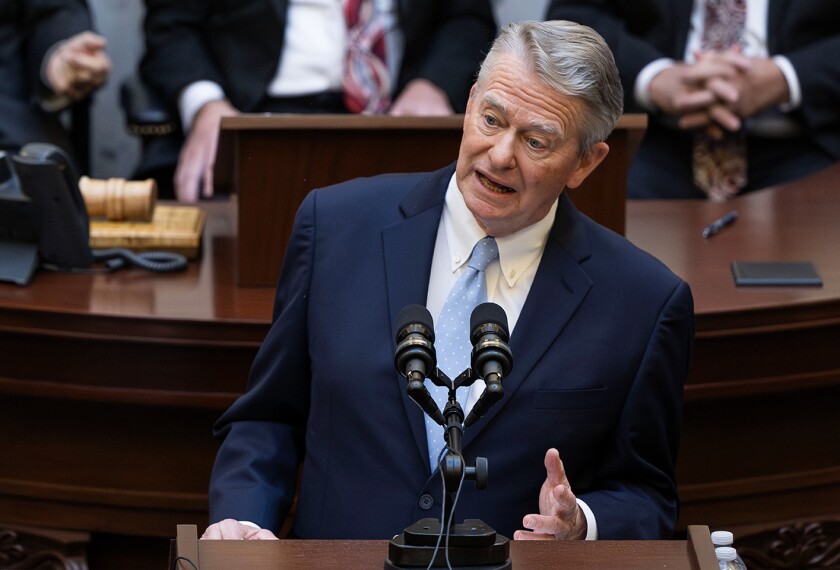With cash unusually scarce in most state capitals, clashes are erupting in legislatures over whether—and how fast—the charter school sector should be allowed to expand its share of the public education pie.
Legislators in Massachusetts, Minnesota, and New York have recently considered proposals for statewide freezes on new charter schools or the expansion of existing ones. Charter supporters have so far fended off those measures, but have had mixed success in achieving their own goals of lifting existing caps or other limits on charter growth in states including Florida, Illinois, New Hampshire, and North Carolina. And in Michigan, the fate of a hard-fought bill that would make room for more charter schools is still up in the air.
As lawmakers debate how many charter schools are enough, heated arguments are breaking out over whether the independent public schools conserve or squander states’ education dollars. And while experts say the answer depends greatly on the vagaries of state charter laws and other dynamics, no one expects those disagreements to end anytime soon.
“Opponents and advocates are going to use this budget crisis to continue to fuel their argument,” predicted Steve Smith, a senior policy specialist in education finance for the Denver-based National Conference of State Legislatures.
To support the case for caps, for example, critics argue that charter schools siphon off resources that school districts sorely need to meet intensifying demands for improved student achievement. Charter supporters, on the other hand, cite the lower per-pupil funding for such schools in many states as one reason not to check their growth.
With several legislatures still in session, it’s too early to say how the debates will play out. But observers with sharply differing views on charters say that 2003 has so far shaped up as better than it might have been for the pro-charter camp.
“There were no big swings either way, and I would think that would constitute a pretty good year from their standpoint,” said Joan Devlin, the associate director of educational issues for the American Federation of Teachers, which supports putting the legislative brakes on charter schooling.
The view from the Center for Education Reform, a Washington-based organization that backs charters and other forms of school choice, is not dramatically different.
“A lot of attempts to water down charter bills significantly did not pass,” said Jeanne Allen, the center’s president. “Overall, there was traction and definitely progress made, despite people’s attempts to do otherwise.”
Putting on the Brakes
The Massachusetts Senate approved an amendment to the proposed state budget last spring that would have imposed a three-year moratorium on charter schools approved after Jan. 1 of this year. The House did not go along with the plan, however, allowing several new schools to open this fall.
Still, proponents of the idea, including the Massachusetts Teachers Association, are hoping to revive it this fall.
“You’re draining resources from the districts for an experiment, and in these difficult financial times, it is very important that you are very careful,” said Catherine A. Boudreau, the president of the MTA, an affiliate of the National Education Association.
Even though Gov. Mitt Romney, a Republican, has said he would veto a moratorium, Marc Kenen, the executive director of the Massachusetts Charter School Association, is taking the threat seriously.
“The charter school opponents are very determined, and so we will have to constantly oppose their efforts to stop charter school growth,” Mr. Kenen said.
His counterpart in Minnesota credits rapid mobilization of charter supporters for the short life of a proposed halt to new charters there that surfaced last spring.
The proposed freeze was quietly added to a school funding bill advanced by the Senate. But the proposal was abandoned just days later, after charter supporters rallied at the state Capitol and proposed trimming funds for charter school facilities and start-up costs as an alternative.
Steve Dess, the executive director of the Minnesota Association of Charter Schools, said the freeze was couched in part as a response to lean budget times.
“This was an opening to hit people where they react the most: the pocketbook,” Mr. Dess said.
Similarly concerned about pocketbook issues, lawmakers in New York put forward a plan for a three-year halt to new charter schools. The measure also would have capped charter school enrollment in individual school districts at 5 percent of that system’s public school enrollment.
The plan, proposed in the spring, did not make it out of the Assembly education committee, however.
Testing Limits
Since Minnesota became the first state to allow charter schools in 1991, states have frequently capped the number of charters that can open. Subsequent measures to ease or eliminate such limits often have been offset by new regulations aimed at tightening oversight of charters.
A new law in Florida follows that pattern. The broad-ranging bill, which took effect in July, eliminates state-imposed caps on the number of charter schools per county, while imposing new accountability and curricular requirements on the schools.
A similar trade-off is part of a compromise enacted in Illinois last spring that increased the limit on charter schools in Chicago from 15 to 30. (“Bill Would Restore Clout to Chicago Teachers,” Feb. 19, 2003.)
In North Carolina, meanwhile, legislation that would have bumped up the statewide cap on charter schools from 100 to 110 fell short at the finish as legislators adjourned in July. Under legislative rules, though, the bills could be revived when lawmakers reconvene next year.
Caps have also been a key issue in a marathon debate in the Michigan legislature over whether to increase the number of charters that can be granted by universities, which have authorized nearly all the state’s charter schools.
The current cap of 150 was reached four years ago, but such legislation remains logjammed following passage in the House and the Senate of dramatically different versions of bills that would address the cap while subjecting charter schools to various new regulations. Under a measure passed by the Michigan Senate in June, universities could give the green light to a total of 240 more schools over the next 10 years.
Gov. Jennifer M. Granholm, a Democrat, made clear that she wouldn’t sign the Senate bill, however. So the House passed a stripped- down version that would allow for 15 charter high schools that a local philanthropist wants to open in Detroit, and the Senate followed suit last month.
But Ms. Granholm won’t sign the Detroit-only bill either, and is holding out for a “more comprehensive” measure that would, among other provisions, impose “an appropriate ceiling” on the number of new charter schools, a spokeswoman for the first-year governor said last week. Legislators from both chambers are trying to resolve their differences with one another and the governor in hopes of passing such a bill this fall.
Meanwhile, New Hampshire is expecting the debut of its first charter schools, under a new measure signed into law in late July.
The Granite State initially passed a charter law in 1995, but no charters have made it through a process that requires a majority of local voters to approve them. That local-approval process will remain an option, but under a 10-year pilot program authorized by the new law, the state board of education can grant final approval for up to two schools a year for a total of 20 charters.
Basic funding for any charter schools approved through the pilot program could be sharply lower than for other public schools, though, because the schools would be assured only the state, and not the local, share of per-pupil funding.
While the New Hampshire program features the kind of caps that charter supporters elsewhere have fought to remove, those limits helped overcome resistance to the idea in the legislature, said Joyce P. Johnson, an administrator for the bureau of school standards in the New Hampshire Department of Education.
“The pilot project said, ‘Don’t be frightened, we’ll only have 20 schools in 10 years,’” Ms. Johnson said.




